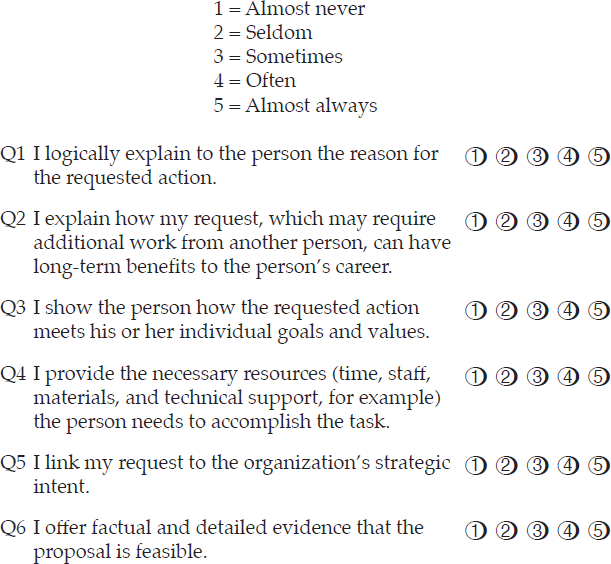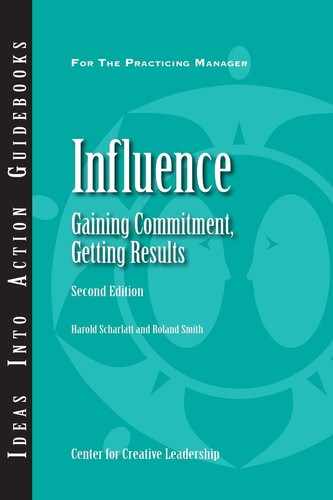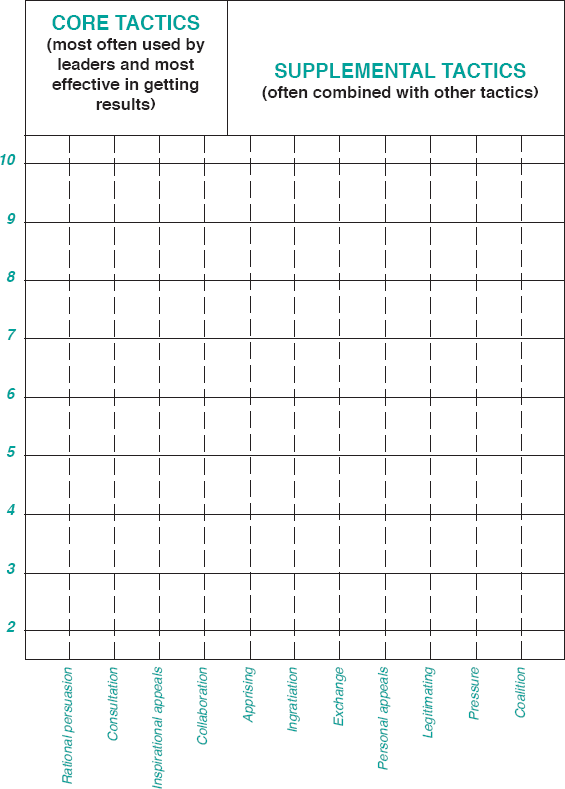How Situation Affects Influence

We speak above about tailoring your influence strategy to the particular person from whom you seek support. We also speak about how you can broaden your tactical choices by assessing which tactics you tend to use more than others. If you try to influence someone to take a different course of action—lend you resources that leave his or her own team shorthanded for a time so that you can meet a critical client deadline, for example—and your appeal does not produce the result you need, there is another aspect of influence you may need to account for. Influence can be highly situational, and you need to read that situation, see how the other person fits in it, and then decide which tactic will serve you best. The ancient Greeks called this kairos, which translates loosely to “the right moment.”
Your Use of Influence Tactics: A Self-Guided Worksheet
Part 1
Respond to the statements below, which describe typical actions taken to influence another person to take an action or perform a task. As you respond to the statements, don’t be too concerned at this point about whether the person is a direct report, peer, boss, or other key stakeholder. Although your choice of influence tactics can depend on who, why, where, and when you influence, in this exercise you are only reporting how often you use certain tactics.
Using the scale below, please rate each statement by darkening the appropriate number.

Part 2
Add up the points for all your responses using the formulas below. The score for each scale will be from 2 to 10 points.
Q1 + Q6 = ______ |
This is your rational persuasion score. |
Q10 + Q15 = ____ |
This is your consultation score. |
Q3 + Q13 = _____ |
This is your inspirational appeals score. |
Q4 + Q9 = ______ |
This is your collaboration score. |
Q2 + Q12 = _____ |
This is your apprising score. |
Q8 + Q19 = _____ |
This is your ingratiation score. |
Q14 + Q20 = ____ |
This is your exchange score. |
Q7 + Q21 = _____ |
This is your personal appeals score. |
Q17 + Q5 = _____ |
This is your legitimating score. |
Q18 + Q11 = ____ |
This is your pressure score. |
Q16 + Q22 = ____ |
This is your coalition score. |
Part 3
Plot each of your scores on the following graph and then connect the dots. This will show which influence tactics you can develop or use more often, either alone or in combination with other tactics.
If you prefer, or if you want an additional graph to mark your progress in using different influence tactics, you can download a copy at www.ccl.org/influence.
One way you can seize the right moment to influence someone is to carefully plan each situation in which you plan to solicit the support of others. Clearly, you cannot plan for every contingency, and sometimes the opportunity to exercise influence can arise unexpectedly. But planning will help you think through different contingencies, develop responses to how others might receive your influence, and imagine alternative tactics so you can switch to one that in the moment may be more effective.
Create your plan in the form of a script in which you describe what you are trying to accomplish and assess the stakeholders from whom you seek endorsement and support. You can also review the influence tactics you tend to favor and those you often avoid using. Imagine the situation and anticipate what kind of reaction you are likely to get. After developing such a plan, you can then map the details of a meeting with the person you need to influence. Using the information in the following sections, think through the actions you will take before and during an influence session. After the session, review your actions and the responses of the person you were trying to influence. Reflect on your efforts so that you can learn from your experience and use what you learn to shape future encounters.
You are more likely to have success influencing others if you establish clear goals, assess your audience, identify appropriate influence tactics, and practice using them. Answering all or some of the following questions can help you work out your thoughts on whom you need to influence and what you want or need to accomplish.
![]() Who is the person you are attempting to influence, and what position does that person occupy relative to yours (boss, peer, direct report, customer, vendor)?
Who is the person you are attempting to influence, and what position does that person occupy relative to yours (boss, peer, direct report, customer, vendor)?
![]() What is the situation? Why has your organization assigned you this task? How much support do you need?
What is the situation? Why has your organization assigned you this task? How much support do you need?
![]() Why did you choose to initiate your request? Why do you need this person’s support for your idea?
Why did you choose to initiate your request? Why do you need this person’s support for your idea?
![]() What do you want the outcome of your influence session to be?
What do you want the outcome of your influence session to be?
![]() What benefits do you and the person you want to influence receive if you handle the situation well? What will it cost you and the person you want to influence to deal effectively with the situation?
What benefits do you and the person you want to influence receive if you handle the situation well? What will it cost you and the person you want to influence to deal effectively with the situation?
![]() Assess the differences and similarities of personal and/or positional power between yourself and the person you want to influence. How can you leverage this power to increase your influence?
Assess the differences and similarities of personal and/or positional power between yourself and the person you want to influence. How can you leverage this power to increase your influence?
![]() What influence tactics should you choose to drive, accelerate, and implement change in your organization?
What influence tactics should you choose to drive, accelerate, and implement change in your organization?
![]() Which tactics do you need to start using or use more of?
Which tactics do you need to start using or use more of?
![]() Which tactics do you need to use less or stop using?
Which tactics do you need to use less or stop using?
Identifying Benefits and Challenges
Each influence effort you make includes things that make it easier and things that make it more difficult. For example, you may have had a negative confrontation in the past with the person you are now hoping to influence. How will you deal with the residual effect of that confrontation? On the positive side, perhaps you have some expertise in a particular area that the organization has recognized and the person you want to influence wants to gain some expertise in that area as well. By identifying these kinds of benefits and challenges, you can capitalize on positive aspects associated with the influence session and address its challenges. You can also increase your chances of successfully influencing the person. The worksheet on page 24 will help you determine the obstacles or challenges that exist in influencing the person. Use it also to highlight benefits or other positive aspects that you can use to increase your chances of success. We have highlighted three broad areas that often connect with benefits and challenges: relationship, politics and power, and skills and knowledge. You may think of other areas in which benefits and challenges exist.
Developing Your Influence Session Script
Given what you know about the person you want to influence and the situation in which you will try to influence that person, describe in detail how a conversation with that person might go. Successfully influencing another person involves more than just making a request. To gain the person’s commitment, you want to engage at a more substantial level—communicating your goal, explaining the benefits of joining your effort, and securing the person’s endorsement.
One place to start when describing your planned scenario is with the influence tactics that are likely to work best given what you know. Review Table 1 on page 14 to choose tactics you think would be the most effective. Then turn to your assessment of your influence tactics skills. Review how you scored yourself on the worksheet on pages 17–20. Pay particular attention to the tactics that you use less frequently, and think about how you can develop them before your influence session to increase your chance of success.
It does not necessarily take a lot of work to develop tactics that you rarely use. For example, you may be skilled with using logical arguments and factual evidence to persuade someone or to make a request. Perhaps the person you want to influence is known for being generous or creative more than analytical. In that case, you can look at your proposal in terms of how it inspires or arouses enthusiasm by appealing to values and ideals.
Benefits (positive factors) |
Challenges (negative factors) |
|
Relationship What kind of working relationship do you have with the person you want to influence? What level of trust and respect exists between the two of you? Have you worked cooperatively in the past? Was that work successful? What made it successful? Have you had or do you have a conflict with this person? What situation led to the conflict? Was it resolved? Are there lingering repercussions? |
||
Politics and Power Does the person you want to influence occupy a higher or lower position than you in the organization? How might that difference affect your influence strategy? Does this person have an informal kind of power in the organization based on interpersonal skills, for example, or a network of peers? How can you use those skills or that network to influence the person? What challenges do they pose for you as you attempt to influence? |
||
Skills and Knowledge Does the person you want to influence possess necessary technical skills and knowledge that would help accomplish your task or contribute to your proposal? Would your project gain the person recognition for the skills or knowledge? Does your project encroach on a technical area that the person regards as his or her domain? |
||
Based on your analysis, is your attempt to influence this person in this situation likely to result in a positive outcome? |
||
Another way to develop your underused influence tactics is to evaluate the benefits you have identified and think about how you can use them to shore up seldom-used tactics. For example, if you are skilled at collaborating but find creating a logical rationale a challenge, perhaps you can reach out to others to help you develop a logical argument. Developing some tactics to the level you need to be an effective influencer may require more practice, coaching, or research. Your goal before starting an influence session is to have confidence in and comfort with the tactics you have chosen to use. The worksheet on page 26 will help you work through your plan.
Conducting an Influence Session
After you have assessed your influence-tactics preferences, described your goals, described the person you are trying to influence, and sketched the groundwork for your influencing session, you are ready to meet with the person you need to influence. Use the ideas you develop with the Influence Session Worksheet to help you stay focused on your goal during the conversation. Interpersonal and communication skills are critical at this stage, so set the stage for your request and establish a rapport with the other person.
Set the stage. Pick the right time and place for your influence session. Find a setting where there will be minimal distractions. Pick a neutral site to minimize personal and positional power differences. Create an atmosphere that encourages openness, optimism, and connection with the person you are attempting to influence.
Establish rapport. Describe the situation. Check to see that the other person understands what you are saying by asking clarifying questions to clear up any confusion, to define problems, to uncover gaps in information, and to encourage accuracy and precision. Be mindful of the impact of your nonverbal communication—body language and tone of voice. Make sure to establish eye contact, smile, and let the person know that you appreciate his or her listening to what you have to say. Watch the person’s reactions to you, and build on points of agreement to create momentum toward the outcome you want.
Which influence tactics are likely to be most effective? |
What specifically will you say and do to use these tactics? |
Anticipate possible responses. What might the person feel or think after your attempt to influence? What might the person say? |
|
Create your counterargument. Plan how you are going to use additional influence tactics to reply, if necessary, to the person’s response. |
|
Identify potential points of mutual agreement and use them to move toward your desired outcome. Secure agreement on your desired outcome. Establish clear steps that both of you will take to accomplish your agreed-upon goals. |
|
End on a positive note. Express your appreciation and communicate your willingness to meet again to check on the progress being made toward the goal. |
|
Reflecting on Your Influence Session
To increase your skill with any leadership practice, it is important to learn from your experiences. Each time you attempt to influence someone, even just to make a small request, take the opportunity to think back over the encounter and how you adjusted your techniques and tactics or chose other tactics altogether. The following questions can guide your learning from experience:
• What went well during the session? Describe the situation and the person’s response.
• What did not go well? Describe the situation and the person’s response.
• Did you get the outcome you wanted? Describe any compromises or modifications to your intended goal.
• What steps did you and the other person agree to take next?
• What did you learn about yourself and your ability to influence others?
• What would you do differently next time?
• What additional support can you find to develop your influence skills?



